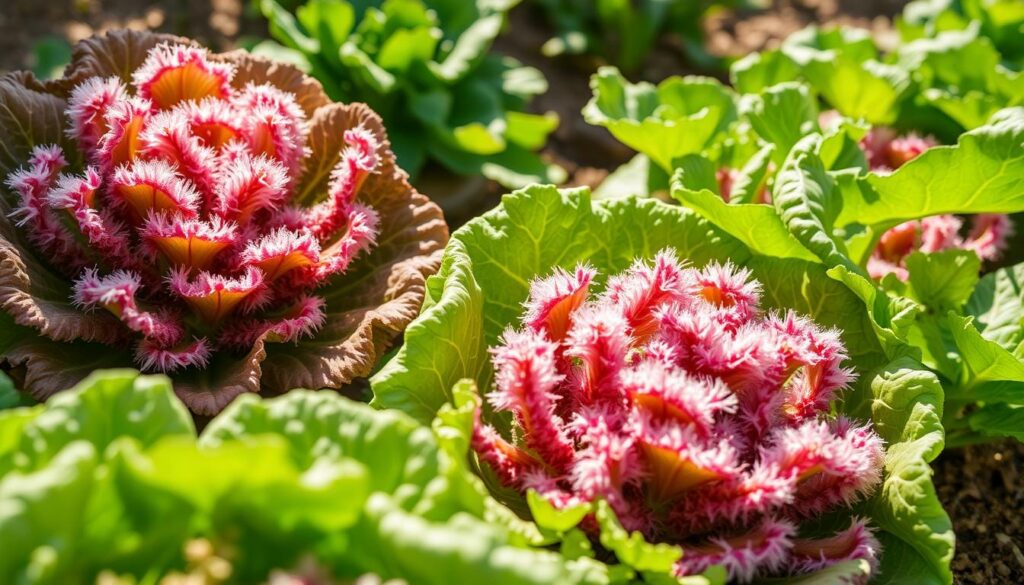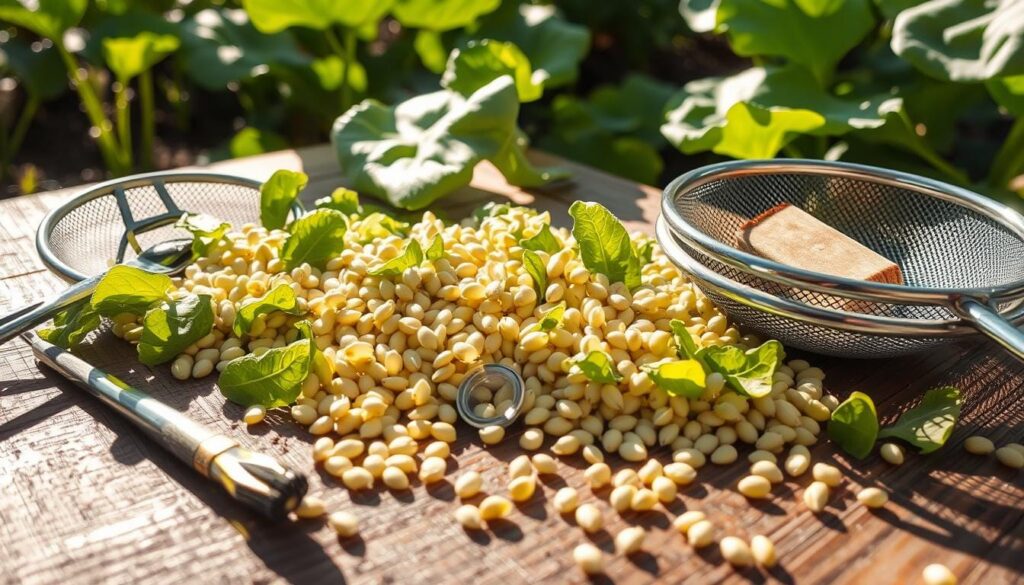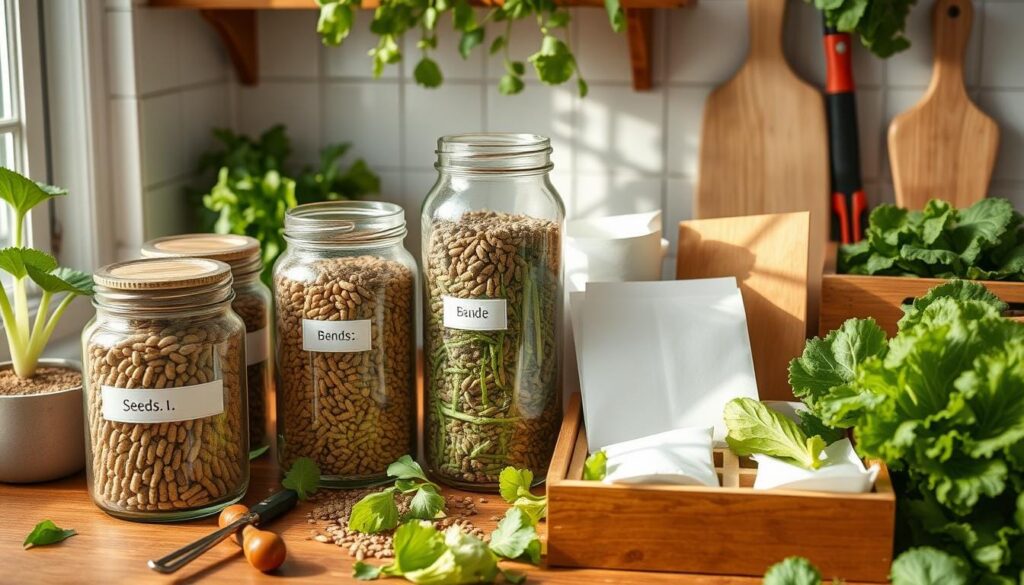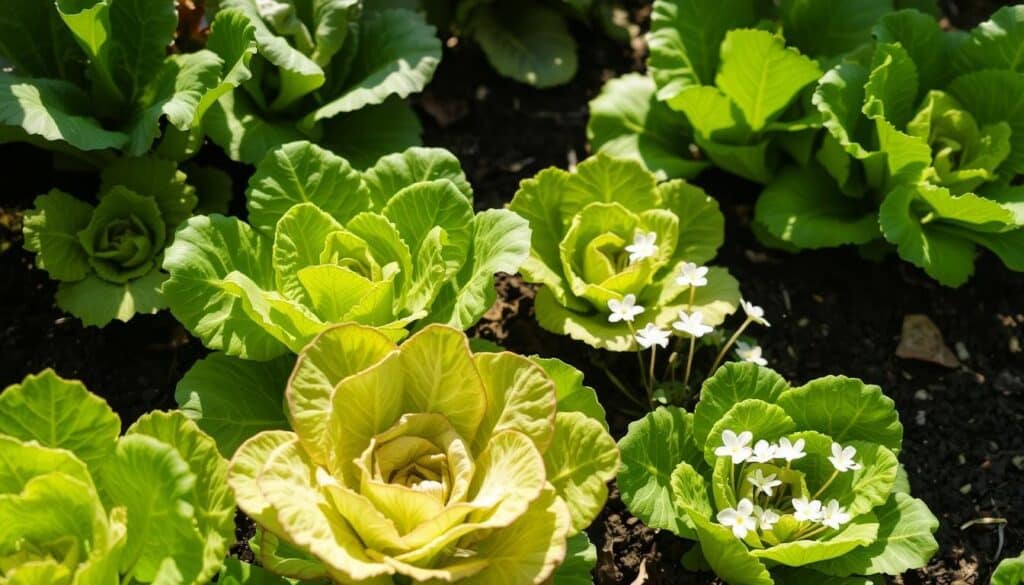Every garden has its own story. For garden lovers, saving lettuce seeds is like writing a chapter of nature’s story. It connects us to the wisdom of past generations.
Harvesting lettuce seeds is more than saving plant genetics. It’s about keeping our bond with the earth strong. Whether you garden in your backyard or dream of saving seeds, learning these techniques can change your gardening journey.
This guide will take you through the detailed steps of saving lettuce seeds. We’ll cover everything from the basics of plants to advanced harvesting methods. You’ll learn how to save seeds and make your garden more sustainable.
Key Takeaways
- Learn essential techniques for successful lettuce seed harvesting
- Understand the critical stages of seed production
- Discover methods to maintain seed purity and viability
- Explore sustainable gardening practices through seed saving
- Gain insights into optimal growing conditions for lettuce
Understanding Lettuce Plant Basics
Lettuce seed collection starts with knowing the basics of lettuce plants. Our guide will help you learn what you need for successful seed harvesting.
Types of Lettuce Plants
Lettuce has many varieties, each with its own traits for seed collection:
- Looseleaf Lettuce: Quick-growing and easy to harvest
- Romaine (Cos) Lettuce: Tall, upright leaves with robust flavor
- Butterhead Lettuce: Soft, tender leaves in a loose head
- Crisphead Lettuce: Compact, tightly packed heads
Growth Cycle and Bolting Process
To collect lettuce seeds, you need to know the plant’s growth cycle. Lettuce goes through these stages:
- Germination (40-65°F)
- Leaf development
- Bolting (flowering and seed production)
“Bolting is the critical point for seed harvesting, when plants transition from leaf production to flowering.”
Ideal Growing Conditions
For successful lettuce seed collection, follow these optimal growing conditions:
| Condition | Recommended Parameters |
|---|---|
| Soil Temperature | 45-65°F (7-18°C) |
| Sunlight | 6-8 hours direct sunlight |
| Planting Depth | 1/8 to 1/4 inch |
| Spacing | 4-16 inches, depending on variety |
By knowing these basics, gardeners can improve their seed harvesting. This ensures successful plant reproduction.
When to Start Growing Lettuce for Seeds
Lettuce seed saving starts with timing and knowing your local growing conditions. Saving lettuce seeds is all about planning and being aware of your environment.
- Start seeds indoors about seven weeks before the last spring frost date
- Make sure soil temperatures are between 50-65ºF for the best germination
- Plant seeds ⅛ inches deep for the best growth
- Give them 6-8 hours of full sun each day
Timing is everything for saving lettuce seeds. Zone 5b gardeners start seeds around March 11. They aim for the frost-free period between April 29 and May 15. Direct sowing happens about four weeks before the last spring frost.
“The key to successful seed production is understanding your plant’s life cycle and local climate conditions.”
For continuous seed harvesting, plan your planting schedule. We suggest sowing seeds every one to two weeks. This way, you’ll have a steady supply of lettuce and more seeds to save.
Important factors for saving lettuce seeds include:
- Keep a distance of at least three meters between plants
- Grow at least 10 plants to keep genetic diversity
- Let 6-10 plants reach full flowering stage
- Watch seed head ripeness closely
Lettuce seeds can last 2-5 years if stored in cool, dark places. By following these tips, you’ll become a pro at saving lettuce seeds and grow a sustainable garden.
Essential Tools and Materials for Seed Harvesting
Getting ready for lettuce seed harvesting needs careful planning and the right tools. You need the right equipment and know how to store seeds properly.
Gardeners need specific tools for a good seed collection. Being prepared helps get more seeds and keeps them in good shape.
Required Equipment
- Sharp pruning shears
- Clean collection bags or containers
- Protective gloves
- Paper envelopes for storing lettuce seeds
- Fine mesh screens
Optional Supplies
- Drying screens
- Small labels
- Moisture-absorbing packets
- Clean white paper for seed collection
Storage Containers
Choosing the right storage container is key for keeping seeds alive. Here are some good options for storing lettuce seeds:
| Container Type | Best For | Storage Conditions |
|---|---|---|
| Glass jars | Long-term storage | Cool, dark, dry environment |
| Paper envelopes | Short-term storage | Low humidity areas |
| Sealed plastic containers | Multiple seed varieties | Airtight with silica gel packets |
Always label containers with the seed variety and harvest date. Store seeds in a cool, dark place with temperatures between 32-41°F. Proper seed storage techniques can keep seeds viable for years.
Pro tip: Separate different lettuce seed varieties to prevent cross-contamination and maintain seed purity.
Preparing Your Lettuce Plants for Seed Production
Starting with the right plant preparation is key to harvesting lettuce seeds. Knowing the plant’s growth cycle is essential. Lettuce plants go through a phase called bolting, where they switch from being leafy greens to seed producers.

To get the most from lettuce seed harvesting, focus on a few important steps:
- Select the healthiest plants with robust growth
- Ensure optimal spacing between plants
- Maintain soil temperatures between 60-70°F
- Keep soil pH balanced at 6.0-6.5
“Seed production begins where vegetable growth ends” – Gardening Wisdom
Lettuce seed production needs the right environment. Temperatures above 80°F can stop seed growth, so timing is everything. We suggest managing plants carefully during the bolting phase.
| Preparation Factor | Optimal Conditions |
|---|---|
| Soil Temperature | 60-70°F |
| Plant Spacing | 12-16 inches within rows |
| Row Separation | 18-30 inches between rows |
| Watering Frequency | Consistent, avoiding flower wetness |
Watching your lettuce plants during seed production takes patience and focus. Look for swelling in the plant’s center, which means bolting has started. By giving them the best growing conditions, we increase our chances of successful seed harvesting.
Signs of Seed Maturity in Lettuce Plants
Knowing when to pick lettuce seeds is key for a good harvest. You need to watch how the plants grow and look for certain signs of readiness.
Visual Indicators of Seed Readiness
As lettuce plants get ready to produce seeds, you’ll see some clear signs. Keep an eye out for these important signs when you’re collecting seeds:
- Light gray pappuses emerging from seed heads
- Flowering stalks becoming branched
- Seed heads turning fluffy and feather-like
- Distinct color changes in seed clusters
Timing Considerations for Seed Development
From when they start to bolt to when they’re ready to harvest, it takes about a month. Here are some key timing tips for collecting lettuce seeds:
| Plant Stage | Duration | Key Characteristics |
|---|---|---|
| Bolting Initiation | 2-3 weeks | Plant develops vertical flowering stalk |
| Seed Formation | 3-4 weeks | Seeds develop on each branch progressively |
| Seed Maturity | 1 month post-bolting | Seeds ready for collection |
Plant Development Stages
Keeping an eye on how your lettuce plants grow is vital for the right seed harvest. Here’s how to know when it’s time to pick:
- Observe initial bolting stage
- Track flowering stalk development
- Watch for seed head formation
- Identify mature, feathery seed clusters
Pro tip: Harvest seeds when the majority of seed heads appear fluffy and light gray for maximum viability.
By knowing these signs, gardeners can collect lettuce seeds with ease and accuracy.
How to Harvest Lettuce Seeds Step by Step
Lettuce seed harvesting is a precise art that requires careful attention and timing. When your lettuce plants begin to bolt, it’s time to prepare for seed collection. We’ll guide you through the essential steps to successfully harvest lettuce seeds and preserve your favorite varieties.
To start harvesting lettuce seeds, follow these critical steps:
- Wait for the lettuce plant to fully bolt and develop flower heads
- Select mature plants with dried, feathery seed heads
- Cut the entire plant at the base using clean pruners
- Tie a piece of twine around the stem
- Hang the plant upside down in a cool, dry location
The key to successful lettuce seed harvesting is timing and proper drying. Mature seeds are identifiable by light gray pappuses emerging from the flower head. Each composite flower can produce between 15 to 25 seeds, giving you a generous harvest from just a few plants.
Pro tip: Allow 1-2 plants from your favorite variety to go to seed for an ample seed collection.
During the lettuce seed harvesting process, protect your seeds from moisture and direct sunlight. We recommend storing collected seeds in a cool, dark location. Properly stored lettuce seeds can remain viable for up to six years, ensuring you always have a reliable seed stock for future gardening seasons.
Methods for Collecting Lettuce Seeds
Collecting lettuce seeds needs precision and careful technique. Our guide covers three main methods for successful seed collection. These methods help gardeners save their favorite varieties and cut down on future planting costs.
There are different ways to collect lettuce seeds, each good for different garden sizes and seed-saving goals. Knowing these techniques will improve your seed harvesting and preservation skills.
Hand-Picking Technique
The hand-picking method is best for small gardeners. It involves:
- Identifying mature seed heads
- Carefully removing individual seed clusters
- Collecting seeds before they naturally disperse
Bag Method for Seed Collection
The bag method is a strategic way to collect lettuce seeds. Gardeners can:
- Use fine mesh bags to cover maturing seed heads
- Prevent seed loss during natural dispersal
- Capture seeds efficiently without manual intervention
Whole Plant Collection Strategy
The whole plant collection is great for large gardens. It involves:
- Cutting entire plants when seeds are mature
- Drying plants completely
- Extracting seeds through gentle threshing
“Patience and careful observation are key to successful seed collection.” – Gardening Expert
| Collection Method | Best For | Difficulty Level |
|---|---|---|
| Hand-Picking | Small gardens | Easy |
| Bag Method | Medium gardens | Moderate |
| Whole Plant Collection | Large gardens | Advanced |
Pro tip: Always ensure your lettuce seed collection method matches your garden’s scale and your specific seed-saving objectives.
Cleaning and Processing Harvested Seeds
Lettuce seed saving is a delicate process that needs careful attention. After you harvest your lettuce seeds, cleaning them properly is key. This ensures the seeds will grow well in the future.

The cleaning process for saving lettuce seeds involves several key steps:
- Separate seeds from chaff using gentle hand techniques
- Use screens or light winnowing methods
- Remove damaged or immature seeds
- Inspect seed quality carefully
When saving lettuce seeds, we recommend using these specific cleaning techniques:
- Hand Cleaning: Gently rub harvested seeds between your hands to separate them from pappuses
- Screening Method: Use fine mesh screens to filter out unwanted plant material
- Winnowing Technique: Blow away light chaff using gentle air movement
Pro Tip: Clean seeds on a dry, sunny day to prevent moisture-related complications.
Successful lettuce seed saving depends on meticulous processing. Make sure your seeds are completely dry before storing them. This usually takes 1-2 weeks in a well-ventilated area. Store cleaned seeds in cool, dark containers to keep them viable for 3-5 years.
Proper Drying Techniques for Lettuce Seeds
Drying lettuce seeds is key to keeping them viable for planting. It’s important to dry them right to ensure they stay healthy for future use.
Knowing the best environment and methods for drying lettuce seeds is vital. We’ll look at the main techniques for drying your seeds well.
Drying Environment Requirements
For lettuce seed drying, a good environment is essential. Here’s what you need:
- Low humidity (around 30-40%)
- Consistent room temperature between 60-70°F
- Good air circulation
- Dark or indirect light conditions
Duration and Methods of Seed Drying
There are several ways to dry lettuce seeds properly:
- Air Drying Method: Spread seeds on a flat, breathable surface like a screen or paper towel
- Silica Gel Technique: Use desiccant to rapidly remove moisture
- Natural Shade Drying: Keep seeds in a well-ventilated area away from direct sunlight
“Patience is key in seed drying – rush the process, and you risk compromising seed quality.” – Gardening Expert
Lettuce seeds usually need 5-7 days to dry properly. To check if they’re dry, do a simple snap test. If they break cleanly when bent, they’re ready for storage.
Storing Lettuce Seeds for Maximum Viability
Keeping lettuce seeds in good condition is key for successful planting later. We’ll look at the best ways to store lettuce seeds. This will help them last longer and germinate better.

Environment plays a big role in storing lettuce seeds. Our research found that seeds can stay good for up to six years if stored right. The main things for successful storage are:
- Temperature control
- Moisture management
- Light protection
- Proper containment
“Seeds are living treasures that require careful preservation.” – Garden Seed Preservation Expert
Now, let’s talk about the best storage conditions for your lettuce seeds:
| Storage Parameter | Recommended Conditions |
|---|---|
| Temperature | Cool (40-50°F) |
| Humidity | Low (below 50%) |
| Container | Airtight glass jar or sealed envelope |
| Light Exposure | Dark environment |
For storing lettuce seeds, use glass jars with tight lids. If you have many varieties, put each in a separate envelope. Then, store them together in one container. A small silica gel packet can help keep moisture away.
Here’s a tip for gardeners at home: Always label your seed containers. Write the harvest date and the variety name on them. This way, you can easily see how old the seeds are and use the freshest ones for planting.
Common Challenges and Solutions in Seed Harvesting
Lettuce seed harvesting can be tough for gardeners. Knowing the challenges helps you collect seeds well and keep your lettuce seed quality high.
Weather-Related Challenges
When you learn to harvest lettuce seeds, you must get ready for changing weather. Extreme temperatures can really affect seed production and how well they grow:
- Temperatures above 80°F can trigger early bolting
- Excessive heat reduces seed germination rates
- Unexpected frost can damage developing seed heads
Pest Management Strategies
Good lettuce seed harvesting needs good pest control. Common pests can ruin your seed collection:
- Aphids can rapidly multiply on lettuce plants
- Slugs and snails damage young seedlings
- Use natural solutions like neem oil for pest control
Disease Prevention Techniques
Keeping lettuce plants healthy is key during seed harvesting. Important prevention steps include:
- Maintain proper air circulation
- Remove diseased plant material immediately
- Choose disease-resistant lettuce varieties
“Successful seed harvesting requires vigilance and proactive management.” – Gardening Expert
By knowing these challenges, gardeners can find ways to harvest lettuce seeds well. This keeps your plants healthy and productive.
Tips for Maintaining Seed Purity
Lettuce seed saving needs careful attention to avoid cross-pollination. This helps keep the genetic quality of your favorite varieties. Lettuce is self-pollinating, which makes it easier to preserve seed purity.

- Keep different lettuce varieties at least three meters apart
- Remove wild lettuce plants to stop unwanted crosses
- Pick the healthiest plants for seed collection
Genetic drift can subtly impact your seed stock over time. To reduce this risk, do the following:
- Label each seed batch with variety and harvest date
- Keep detailed records of plant characteristics
- Rotate seed stock to keep genetic diversity
The key to successful lettuce seed saving is patience and precision in your gardening approach.
Following these practices will help you get consistent, high-quality seeds. By understanding seed collection and maintenance, you can keep your favorite lettuce varieties for years.
Conclusion
Learning how to harvest lettuce seeds is a great skill for gardeners. It connects us to the natural cycle of plant life. We’ve looked at how lettuce seeds grow from tiny beginnings to mature plants that can produce hundreds of seeds.
We’ve shown you how to harvest lettuce seeds, from knowing when to pick to storing them. These steps help gardeners save money and keep rare varieties alive. They also deepen our understanding of how seeds are made.
Starting your own lettuce seed harvesting journey? Be patient and watch closely. Every seed holds promise, whether it’s from Parris Island Romaine or other types. By using our methods, you’ll learn to collect and store seeds for next year’s garden.
We invite you to try these techniques and explore different lettuce varieties. Seed saving is a rewarding experience. Your garden will grow more, and you’ll feel connected to nature’s cycle.

